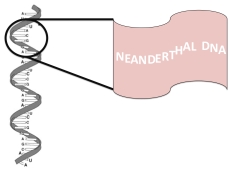Are we Neandermans or Neandumans?
 Science and Nature have just published research that supports a hypothesis about Neanderthal-human hybridisation that I published with Professor Roger Valentine Short in 2011. The recent popularity of the hybridisation theory was also reported in Nature news, Fox News, and National Public Radio.
Science and Nature have just published research that supports a hypothesis about Neanderthal-human hybridisation that I published with Professor Roger Valentine Short in 2011. The recent popularity of the hybridisation theory was also reported in Nature news, Fox News, and National Public Radio.
I was first inspired to think deeply about patterns of interbreeding between Neanderthals and humans while teaching Human Evolution and Diversity at Macquarie University in 2010. I approached Roger Short from Melbourne University with some of my ideas and we ended up writing a paper together. Famous for his work on elephants, Roger has also worked on hybridising camels and lamas. His work on Haldane’s law was a crucial part to building our Neanderthal-human hybridisation hypothesis.
Africans do not have Neanderthal ancestry. Interbreeding between Neanderthals and humans occurred as some groups migrated outside Africa between 80,000 years and 50,000 years ago. Looking at experimental studies of nuclear DNA and mitochondrial DNA from both humans and Neanderthals, Roger Short and I have hypothesised that Neanderthal men mated successfully with female humans but not vice-versa. Turning to Haldane’s law, we conjectured that the offspring were predominantly female hybrids. Male hybrids were uncommon, absent or sterile. Beyond the evidence from nuclear and mitochondrial DNA, this hypothesis also gels well with data from the Y chromosome that indicates that the human Y chromosomes came entirely from Africa. The recent experimental work published in Science and Nature bolsters our excitement in the hybridisation hypothesis. Great-Great-Great Grandma, as it turns out, was likely the hybrid offspring of a Neanderthal male and a female human.
In science, the method of naming hybrid offspring usually follows the rule that the first half of the name comes from the male parent and the second half comes from the female parent. For example, a liger is the offspring of a male lion and a female tiger, a cama is the offspring of a male camel and a female llama, and a zorse is the offspring of a male zebra and a female horse. Given this conventional naming practice for hybrids, should humans living outside of Africa actually call themselves NEANDUMANS? What do you think?
Science:
http://www.ncbi.nlm.nih.gov/pubmed/24476670
http://www.sciencemag.org/content/343/6174/1017
Nature:
http://www.ncbi.nlm.nih.gov/pubmed/24476815
http://www.nature.com/nature/journal/v507/n7492/full/nature12961.html
Hypothesis:
Neanderthal-human hybrids
The Origin and Future of Modern Humans
COSMOS:
My great-great-great grandfather’s a Neanderthal
Did better mothering defeat the Neanderthals?
Ancient tryst fortified human immune systems
Other authors who have looked at the problem of Neanderthal-human hybridisation:
Karenleigh A. Overmann & Frederick L. Coolidge;
Chuan-Chao Wang, Sara E. Farina, & Hui Li;
Catalyst:
http://www.abc.net.au/catalyst/stories/3593813.htm
John Hawks on Neanderthals:
http://johnhawks.net/
Sean Carroll on hybrids:
http://www.nytimes.com/2010/09/14/science/14creatures.html?_r=0
Following the trend of the newborn Zonkey, I vote for Numan. “Hello, Numan!”
Did we get parts of our X chromosome from male Neanderthals? If so, does this have implications for how we understand diseases, autoimmune disorders and other conditions that affect one sex more than the other?
Neanderman!
neanduman
According to your article, the correct name would be Numan, no?